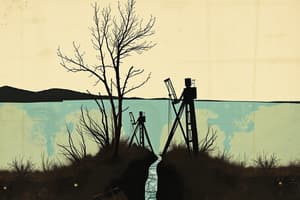Podcast
Questions and Answers
What defines waterfalls according to the text?
What defines waterfalls according to the text?
- Small isolated patches
- Magnificent jumps made by stream or river water (correct)
- Specific parts of the course
- Large caps
Which term is associated with small isolated patches?
Which term is associated with small isolated patches?
- Mesa
- Waterfalls
- Butte/kopjees (correct)
- Magnificent jumps
What characterizes Mesas according to the text?
What characterizes Mesas according to the text?
- Small isolated patches
- Magnificent jumps
- Large caps (correct)
- Specific parts of the course
Where do waterfalls occur based on the text?
Where do waterfalls occur based on the text?
Which feature describes Butte/kopjees according to the text?
Which feature describes Butte/kopjees according to the text?
What happens to rocks or other materials when groundwater percolates through them?
What happens to rocks or other materials when groundwater percolates through them?
What do rocks or other materials gain in return when groundwater percolates through them?
What do rocks or other materials gain in return when groundwater percolates through them?
How do rocks or other materials interact with groundwater during percolation?
How do rocks or other materials interact with groundwater during percolation?
What is one consequence of the interaction between rocks and groundwater during percolation?
What is one consequence of the interaction between rocks and groundwater during percolation?
Which statement best describes the relationship between rocks or materials and groundwater during percolation?
Which statement best describes the relationship between rocks or materials and groundwater during percolation?
What is a defining characteristic of caves?
What is a defining characteristic of caves?
How are caves formed?
How are caves formed?
What type of openings do caves typically have on the surface?
What type of openings do caves typically have on the surface?
Which of the following is NOT true about caves?
Which of the following is NOT true about caves?
What distinguishes caves from man-made tunnels?
What distinguishes caves from man-made tunnels?
What is one of the types of motions of the ice in a glacial mass?
What is one of the types of motions of the ice in a glacial mass?
What causes the sliding motion of a glacial body along the bedrock?
What causes the sliding motion of a glacial body along the bedrock?
In glacial transport, what is the role of gravity in the movement of ice?
In glacial transport, what is the role of gravity in the movement of ice?
What is the primary reason for the net movement of a glacier?
What is the primary reason for the net movement of a glacier?
Which type of motion accounts for the glacial transport mentioned in the text?
Which type of motion accounts for the glacial transport mentioned in the text?
What distinguishes tectonic earthquakes from non-tectonic earthquakes?
What distinguishes tectonic earthquakes from non-tectonic earthquakes?
Which of the following is NOT a cause of non-tectonic earthquakes?
Which of the following is NOT a cause of non-tectonic earthquakes?
What is the primary cause of tectonic earthquakes according to the text?
What is the primary cause of tectonic earthquakes according to the text?
Which type of earthquake originates from causes different from faulting?
Which type of earthquake originates from causes different from faulting?
What is an example of a cause that can lead to a non-tectonic earthquake as per the text?
What is an example of a cause that can lead to a non-tectonic earthquake as per the text?
Flashcards are hidden until you start studying
Study Notes
Landforms
- Mesas are large, flat-topped landforms with steep sides
- Buttes/kopjees are small, isolated patches of landforms with steep sides
Waterfalls
- Waterfalls are magnificent jumps made by stream or river water at certain specific parts of their course
Caves
- Caves are naturally carved out underground cavities of various dimensions
- Caves have horizontal openings on the surface
- Caves are formed through the process of groundwater percolation, where rocks or other materials lose some of their constituents to the ground water molecules and take in return some component molecules from the ground water
Glacial Transport
- Glacial transport is the result of two types of motions of the ice in a glacial mass
- The first type of motion is a sliding motion of the glacial body along the bed rock, primarily due to gravity
Earthquakes
- There are two broad types of earthquakes: tectonic and non-tectonic
- Tectonic earthquakes are caused by faulting or relative displacements of Earth's crust blocks along rupture planes
- Non-tectonic earthquakes originate from causes different from faulting, such as volcanic eruptions, atomic explosions, landslides, and subsidence
Studying That Suits You
Use AI to generate personalized quizzes and flashcards to suit your learning preferences.




